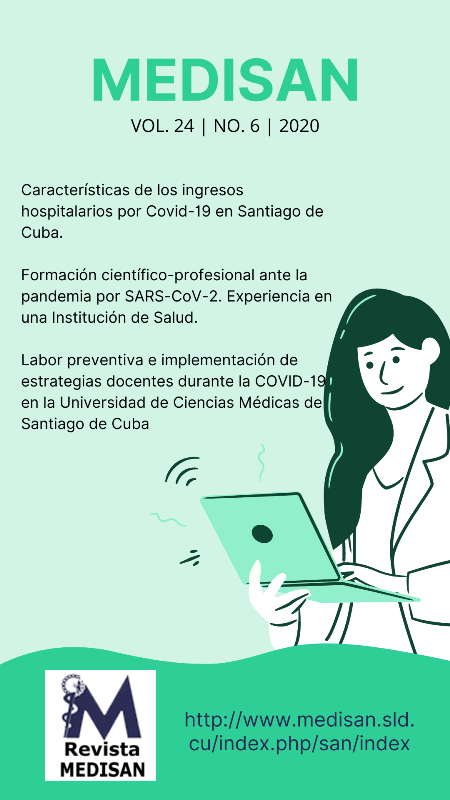Clinical epidemiological characterization of Algerian children with infectious diseases
Keywords:
niño, adolescente, enfermedades infecciosas, morbilidad, mortalidad, Argelia.Abstract
Introduction: Children represent the future, so their healthy growth and development should be a priority for all societies, that is the reason why the Health World Organization creates strategies to minimize the causes that conspire against the health of children and adolescents.
Methods: A descriptive and longitudinal study of the 4 109 children over 28 days and under 14 years with infectious diseases was carried out, who were assisted in the Pediatrics Service of Mohamed Boudiaf Teaching Clinical Surgical Hospital, in the Bayadh province, Popular and Democratic Republic of Algeria, during 2017-2018.
Objective: To characterize Algerian children with 28 days and under 14 years with infectious diseases from the clinical epidemiological point of view.
Results: It was obtained that 88.4 % of the members in the study suffered from infectious diseases and 11.6 % suffered from non infectious diseases; equally, those under one year and from the male sex were the ones that mostly get ill (58.0 %), as long as, acute diarrheic diseases and breathing infections were the most frequent (48.0 and 32.0 %, respectively). Of the total of patients, 3 607 had a favorable clinical course (99.8 %).
Conclusions: Infectious diseases constitute a health problem in Algeria that continues contributing to increase sick and dead children due to this cause; also, acute diarrheic diseases and acute breathing infections are the main causes of hospital assistance in Bayadh province, caused due to the early weaning and malnutrition, factors that contribute to the high incidence of morbidity and low mortality, reason why patients under 5 years should receive a special care, mainly those under one year who get sick with more frequency.
Downloads
References
2. Organización Panamericana de la Salud. Organización Mundial de la Salud. Salud en las Américas, 2017 [citado 06/01/2020]. Disponible en: https://www.paho.org/salud-en-las-americas-2017/wp-content/uploads/2017/09/Print-Version-Spanish.pdf
3. García Corzo JR, Niederbacher Velásquez J, González Rugéles CI, Rodríguez Villamizar LA, Machuca Pérez M, Torres Prieto A, et al. Etiología viral de infecciones respiratorias agudas en niños menores de 5 años en las provincias Comunera y García Rovira de Santander. Rev Univ Ind Santander Salud. 2016 [citado 06/01/2020]; 48(2). Disponible en: http://www.scielo.org.co/scielo.php?script= sci_ arttext&pid= S012108 072016000200011&lng=en
4. Escosa García L. Infectología pediátrica. Actualización en enfermedades infecciosas prevalentes, 2018 [citado 06/01/2020]. Disponible en: https://docplayer.es/35168372-Infectologia-pediatrica-actualizacion-en-enfermedades-infecciosas-prevalentes.html
5. Navia E. Infecciones infantiles frecuentes. Cinfasalud, 14 de febrero 2019 [citado 06/01/2020]. Disponible en: https://cinfasalud.cinfa.com/p/infecciones-infantiles-frecuentes/
6. Oliva González Y. Clínica y epidemiologia de las infecciones respiratorias agudas en pacientes de 0–14 anos. Rev Ciencias Méd Pinar del Río. 2013 [citado 06/01/2020]; 17(1). Disponible en: http://scielo.sld.cu/scielo.php?script=sci_arttext&pid=S1561-31942013000100006
7. Hawwa Vissing N, Lund Chawes B, Arendt Rasmussen M, Bisgaard H. Epidemiologia y factores de riesgo en la primera infancia. Pediatrics. 2018 [citado 06/01/2020];141(6). Disponible en: https://www.intramed.net/contenidover.asp?contenidoid=92877
8. González Corona EA. Diarrea aguda, prolongada y persistente en niños y su diferencia de la diarrea crónica. MEDISAN. 2017 [citado 06/01/2020];21(9):2047-60 Disponible en: http://scielo.sld.cu/scielo.php?script=sci_arttext&pid=S1029-30192017000900012&lng=es
9. Organización Mundial de la Salud. Estrategia Mundial para la Salud de la Mujer, el Niño y el Adolescente (2016-2030), 2015 [citado 06/01/2020]. Disponible en: https://www.who.int/maternal_child_adolescent/documents/estrategia-mundial-mujer-nino-adolescente-2016-2030.pdf?ua=1
10. Organización Panamericana de la Salud. Tratamiento de las enfermedades infecciosas 2017-2018 [citado 06/01/2020]. Disponible en: https://iris.paho.org/handle/10665.2/51590?show=full
11. García Peris M, Jiménez Candel I, Mañes Jiménez Y, Pariente Martí M, González Granda D, Calvo Rigual F. Primoinfección por el virus Epstein-Barr en niños sanos. An Pediatr (Barc). 2019 [citado 06/01/2020];90(6):376-85. Disponible en: https://www.sciencedirect.com/science/article/pii/S169540331830345X
12. Tagarro A, Cruz Cañete M, Otheo E, Launes C, Couceiro JA, Pérez C, et al. Oseltamivir para el tratamiento de la gripe en niños y adolescentes. An Pediatr (Barc). 2019 [citado 06/01/2020];90(5):37. Disponible en: https://www.sciencedirect.com/science/article/pii/S1695403319300268
13. Roi Piñeiro MJ, Cilleruelo J, Ares Álvarez J, Baquero Artiga F. Recomendaciones sobre el diagnóstico y tratamiento de la infección urinaria. An Pediatr (Barc). 2019 [citado 06/01/2020];90(6):400-9. Disponible en: https://www.analesdepediatria.org/es-recomendaciones-sobre-el-diagnostico-tratamiento-articulo-S1695403319301389
14. Povea Alfonso E, Hevia Bernal D. La enfermedad diarreica aguda. Rev Cubana Pediatr. 2019 [citado 22/12/2019];91(4). Disponible en: http://www.revpediatria.sld.cu/index.php/ped/article/view/928/467
15. Coronel Carvajal C, Huerta Montaña Y, Ramos Téllez O. Factores de riesgo de la infección respiratoria aguda en menores de cinco años. AMC. 2018 [citado 22/12/2019];22(2). Disponible en: http://scielo.sld.cu/scielo.php?script=sci_arttext&pid=S1025-02552018000200009
16. Organización Mundial de la Salud. Enfermedades diarreicas agudas, 2017 [citado 22/12/2019]. Disponible en: https://www.who.int/es/news-room/fact-sheets/detail/diarrhoeal-disease
17. UNICEF/OMS. Declaración conjunta de la OMS y el UNICEF. Tratamiento clínico de la diarrea aguda, 2018 [citado 22/12/2019]. Disponible en: https://apps.who.int/iris/bitstream/handle/10665/70201/WHO_FCH_CAH_04.7_spa.pdf?sequence=1&isAllowed=y
18. Programa de las Naciones Unidas para el Desarrollo. Informe sobre desarrollo humano, 2016 [citado 22/12/2019]. Disponible en: http://hdr.undp.org/en/media/globalincometrends.pdf
Published
How to Cite
Issue
Section
License
All the articles can be downloaded or read for free. The journal does not charge any amount of money to the authors for the reception, edition or the publication of the articles, making the whole process completely free. Medisan has no embargo period and it is published under the license of Creative Commons, International Non Commercial Recognition 4.0, which authorizes the copy, reproduction and the total or partial distribution of the articles in any format or platform, with the conditions of citing the source of information and not to be used for profitable purposes.





